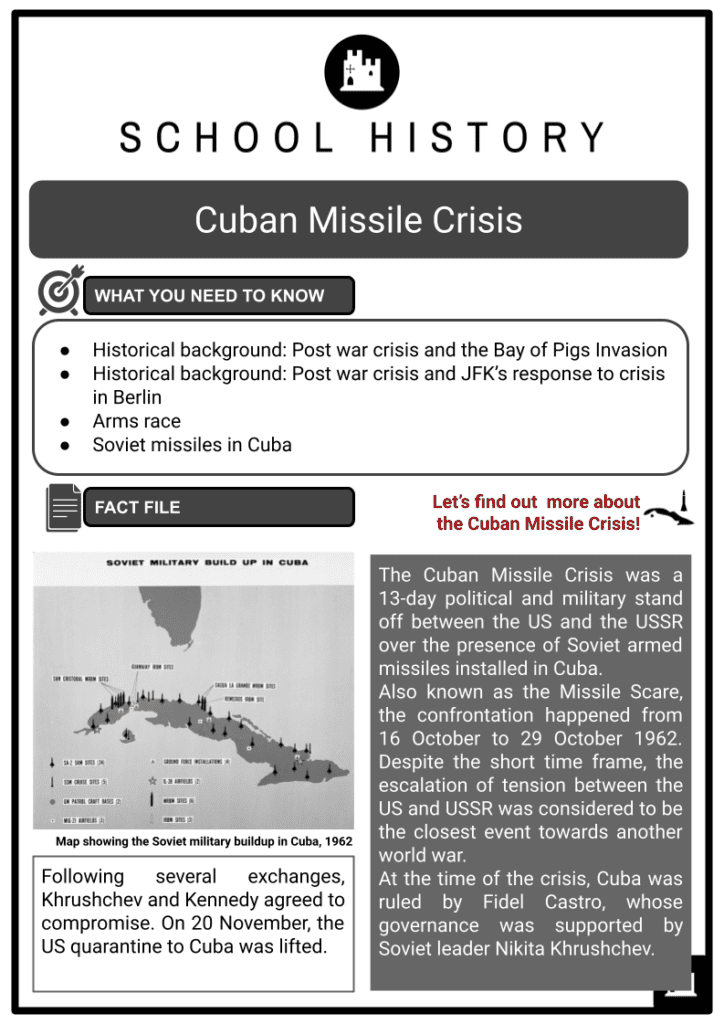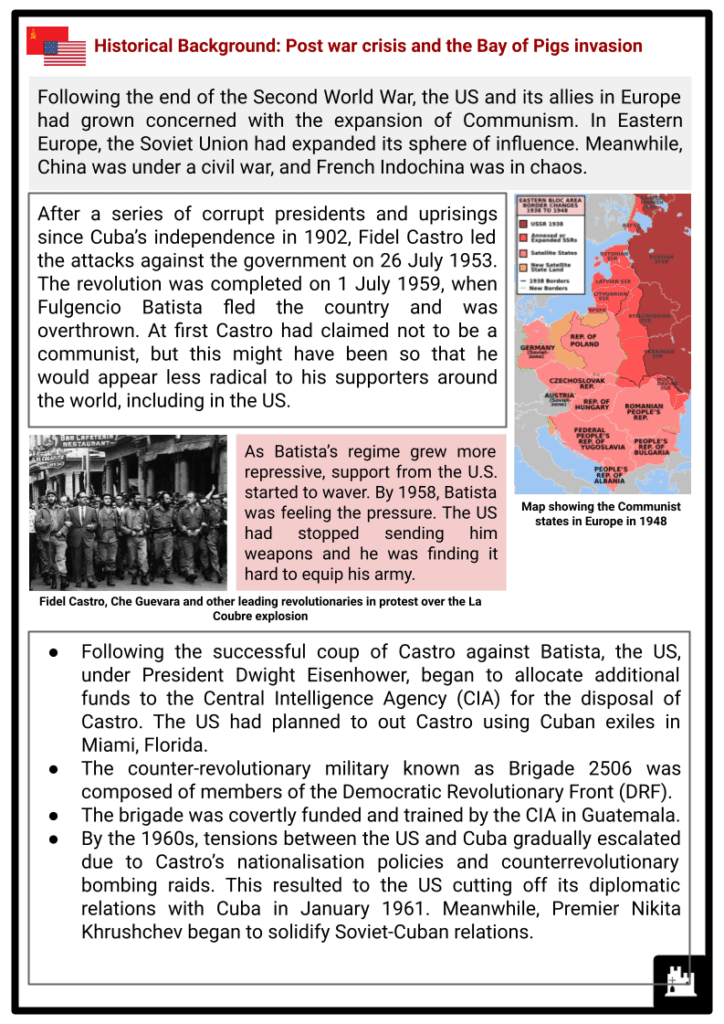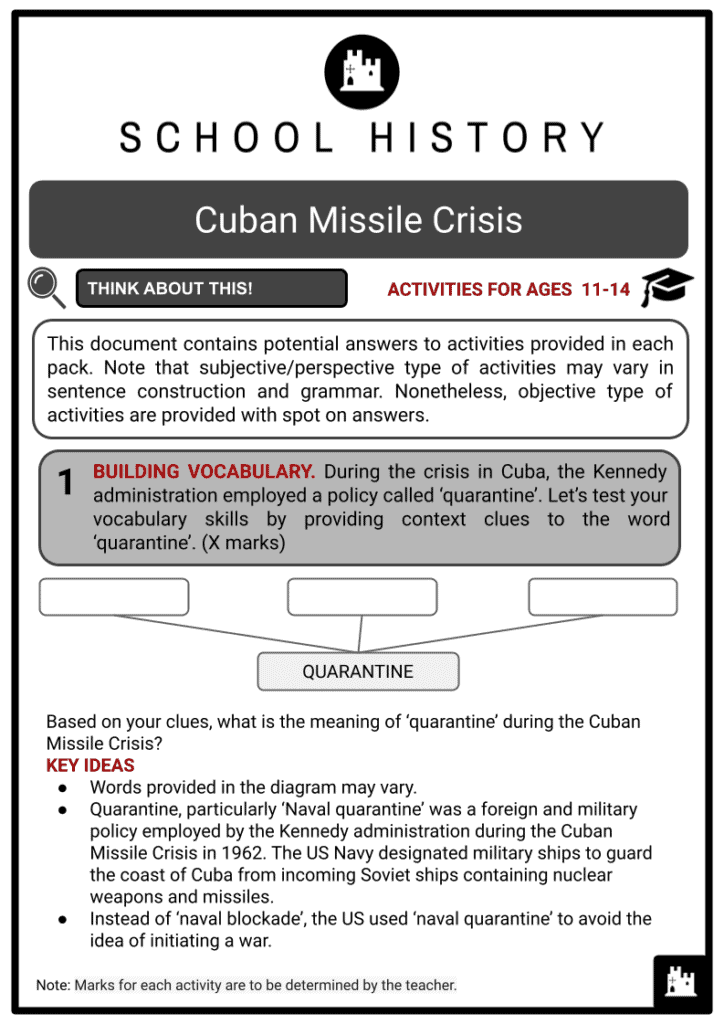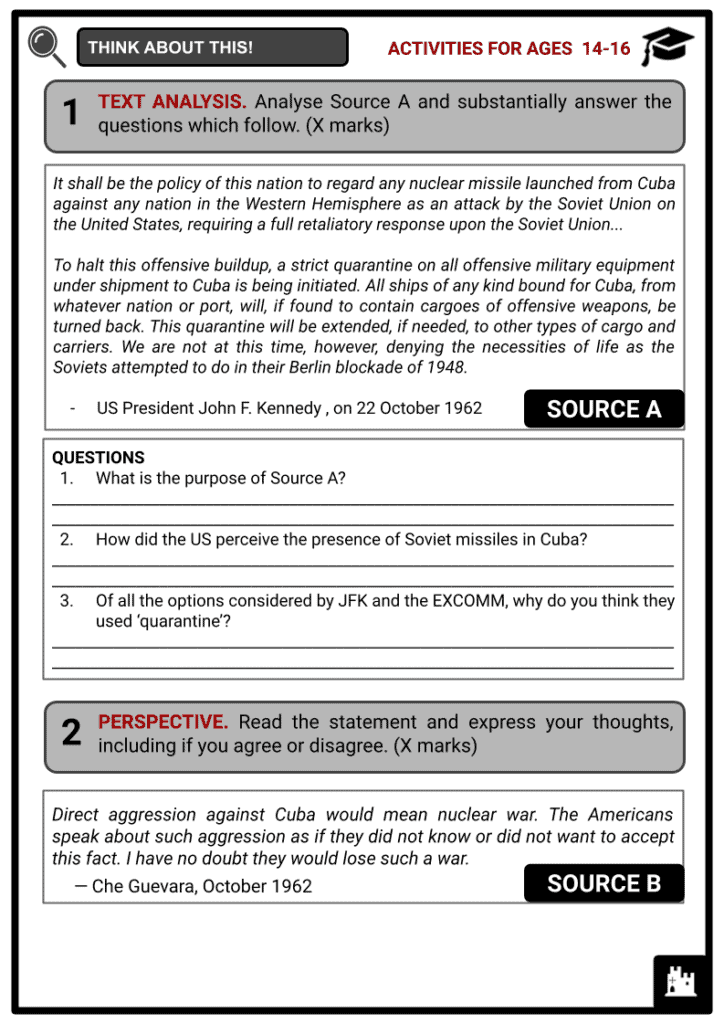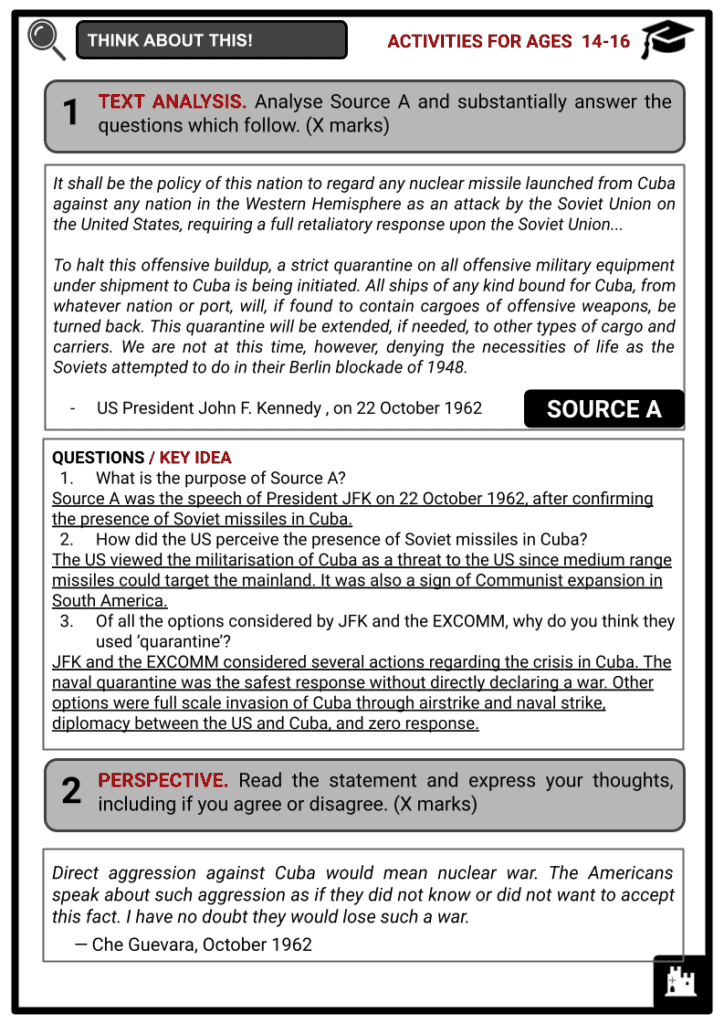Download The Cuban Missile Crisis
Do you want to save dozens of hours in time? Get your evenings and weekends back? Be able to teach The Cuban Missile Crisis to your students?
Our worksheet bundle includes a fact file and printable worksheets and student activities. Perfect for both the classroom and homeschooling!
Summary
- Historical background: Post war crisis and the Bay of Pigs Invasion
- Historical background: Post war crisis and JFK’s response to crisis in Berlin
- Arms race
- Soviet missiles in Cuba
Key Facts And Information
Let’s find out more about the Cuban Missile Crisis!
- Following several exchanges, Khrushchev and Kennedy agreed to compromise. On 20 November, the US quarantine to Cuba was lifted.
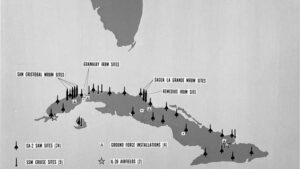
- The Cuban Missile Crisis was a 13-day political and military stand off between the US and the USSR over the presence of Soviet armed missiles installed in Cuba.
- Also known as the Missile Scare, the confrontation happened from 16 October to 29 October 1962. Despite the short time frame, the escalation of tension between the US and USSR was considered to be the closest event towards another world war.
- At the time of the crisis, Cuba was ruled by Fidel Castro, whose governance was supported by Soviet leader Nikita Khrushchev.
Historical Background: Post war crisis and the Bay of Pigs invasion
- Following the end of the Second World War, the US and its allies in Europe had grown concerned with the expansion of Communism. In Eastern Europe, the Soviet Union had expanded its sphere of influence. Meanwhile, China was under a civil war, and French Indochina was in chaos.
- After a series of corrupt presidents and uprisings since Cuba’s independence in 1902, Fidel Castro led the attacks against the government on 26 July 1953. The revolution was completed on 1 July 1959, when Fulgencio Batista fled the country and was overthrown. At first Castro had claimed not to be a communist, but this might have been so that he would appear less radical to his supporters around the world, including in the US.
- As Batista’s regime grew more repressive, support from the U.S. started to waver. By 1958, Batista was feeling the pressure. The US had stopped sending him weapons and he was finding it hard to equip his army.
- Following the successful coup of Castro against Batista, the US, under President Dwight Eisenhower, began to allocate additional funds to the Central Intelligence Agency (CIA) for the disposal of Castro. The US had planned to out Castro using Cuban exiles in Miami, Florida.
- The counter-revolutionary military known as Brigade 2506 was composed of members of the Democratic Revolutionary Front (DRF).
- The brigade was covertly funded and trained by the CIA in Guatemala.
- By the 1960s, tensions between the US and Cuba gradually escalated due to Castro’s nationalisation policies and counterrevolutionary bombing raids. This resulted to the US cutting off its diplomatic relations with Cuba in January 1961. Meanwhile, Premier Nikita Khrushchev began to solidify Soviet-Cuban relations.
- Composed of 1,400 Cuban exiles, the brigade was divided into five infantry battalions and one paratrooper battalion.
- On 17 April 1961, newly elected US President John F. Kennedy launched Operation Mongoose, also known as the Bay of Pigs invasion. From Guatemala and Nicaragua, the Cuban paramilitaries faced a massive counter-offensive from Castro’s Cuban Revolutionary Armed Forces (FAR).
- Within three days, the US-led invasion was defeated by FAR. By 20 April 1961, many counter revolutionary troops surrendered. They were arrested, interrogated, and imprisoned.
- As a result of the failed invasion, Castro’s rule over Cuba was solidified. Many of the local population viewed him as a hero.
Historical Background: Post war crisis and JFK’s response to crisis in Berlin
- From 4 June until 9 November 1961, the Berlin Crisis ensued between Soviet-controlled East Germany and Allied-occupied West Germany. Khrushchev released the Berlin Ultimatum which demanded the withdrawal of Allied armed forces from Berlin. The crisis culminated the building of the Berlin Wall which physically divided East and West Berlin.
- On 13 August 1961, the Soviet-supported East Germany began the construction of the Berlin Wall. In response, the US did not intervene. When Khrushchev’s deadline passed, the USSR did no further actions.
"I know for certain that Kennedy doesn't have a strong background, nor, generally speaking, does he have the courage to stand up to a serious challenge." - Nikita Khrushchev on JFK’s response to the Berlin Crisis
- After Kennedy’s response to the crisis in Berlin, Khrushchev’s impression of the US President solidified. The Soviet Premier viewed him as young and intellectual, but too weak to decide in a situation of crisis.
Arms Race
- By the time of Kennedy’s election in 1960, the Soviet Union only had 4 intercontinental ballistic missiles (R-7 Semyorka). According to US intelligence, the Soviets produced about 75 ICBMs by October 1962. On the other hand, the US had 170 ICBMs, and 8 ballistic missile submarines.
- Despite Khrushchev’s claim of a missile gap, the Soviets had about 700 medium-range ballistic missiles. For the total number of warheads, the US had 27,000, while the Soviets had around 3,600.
- Moreover, the US was also leading in terms of missile defensive capabilities, naval, and air power. However, the Soviets had considerable advantage in conventional ground forces including field guns and tanks.
- In 1962, the ICBMs had poor accuracy and reliability. The more reliable ICBMs only existed post-1965.
Soviet Missiles in Cuba
- Following the failed Bay of Pigs invasion, the US had been deploying U-2 surveillance over Cuba. In September 1962, analysts from the Defense Intelligence Agency (DIA) observed surface-to-air missile sites in Cuba arranged in a Soviet pattern.
- On 9 October 1962, US reconnaissance missions over Cuba resumed. On 15 October, the U-2 photographs were analysed by the National Photographic Interpretation Centre (NPIC) of the CIA. They identified that they were medium range ballistic missiles. The report was strengthened by the CIA and MI6’s double agent to GRU, Oleg Penkovsky.
- That evening, the CIA informed the Department of State. The following day, McGeorge Bundy, National Security Advisor of the United States met President Kennedy and reported the U-2 photographs.
- By 6:30 pm, 16 October 1962, Kennedy met with the Executive Committee of the National Security Council (EXCOMM). The EXCOMM was composed of nine members of the National Security Council and other five advisers.
- On the same day, Kennedy notified his brother and US Attorney General, Robert Kennedy, about the presence of Soviet missiles in Cuba. Kennedy argued that it was a legitimate threat against the US.
- In response, Robert Kennedy contacted Soviet Ambassador to the US, Anatoly Dobrynin. As instructed by Khrushchev, Dobrynin responded that the missiles were purely defensive in nature. Khrushchev also assured the Kennedy administration that the Soviets had no intention of disrupting the US-USSR relations.
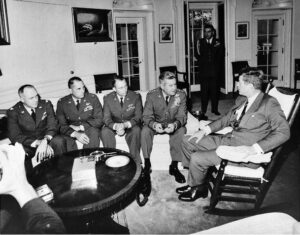
- By 6:30 pm, 16 October 1962, Kennedy met with the Executive Committee of the National Security Council (EXCOMM). The EXCOMM was composed of nine members of the National Security Council and other five advisers.
- On the same day, Kennedy notified his brother and US Attorney General, Robert Kennedy, about the presence of Soviet missiles in Cuba. Kennedy argued that it was a legitimate threat against the US.
- In response, Robert Kennedy contacted Soviet Ambassador to the US, Anatoly Dobrynin. As instructed by Khrushchev, Dobrynin responded that the missiles were purely defensive in nature. Khrushchev also assured the Kennedy administration that the Soviets had no intention of disrupting the US-USSR relations.
- Vice President Lyndon B. Johnson, who was part of the EXCOMM, discussed the possible courses of action:
- Do nothing
- Through diplomacy, ask the Soviets to remove the missiles
- Offer Castro to split with the USSR, or invade Cuba
- Invasion of Cuba
- Air strike the missile sites
- Impose a quarantine to Cuba in order to block them having any more Soviet missiles
- The Joint Chiefs of Staff agreed in the full scale invasion of Cuba and overthrowing Castro. However, Kennedy remained skeptical about it. He assumed that attacking Cuba through an airstrike would give the Soviets a green signal to invade Berlin.
- On 18 October, JFK met Soviet Minister of Foreign Affairs, Andrei Gromyko, who reiterated that the missiles had no offensive purpose.
- The following day, 19 October, U-2 spies confirmed four operational sites in Cuba. The US devised two Operational Plans (OPLAN). OPLAN 316 involved a full invasion of Cuba using the US Army, Navy, and Air Force. Meanwhile, OPLAN 312 will deploy the Air Force and the Navy.
- On 21 October, the EXCOMM was left with two actions: a naval quarantine of Cuba and an airstrike targeting the bases. US Secretary of Defense, Robert McNamara supported the naval quarantine. Instead of using the term ‘blockade’, the Kennedy administration used ‘quarantine’ to not impose an act of war.
- On 22 October, 3 o’ clock pm, President Kennedy formally created the EXCOMM with the National Security Action Memorandum (NSAM) 196. Before Kennedy’s speech, US delegations met the leaders of Canada, United Kingdom, West Germany, and France.
- Over the course of the Cuban Missile Crisis, Kennedy had regular correspondence with British Prime Minister Harold Macmillan.
- Before his televised speech, Kennedy called former president Eisenhower. Both of them anticipated that Khrushchev would respond to Berlin.
- At exactly 7 pm, Kennedy addressed the American public about the discovery of missiles in Cuba and the US response. His speech placed the US under DEFCON 3 or defence readiness condition. USS Newport News served as the flagship of the quarantine, supported by USS Leary.
- On 23 October, the US Ambassador in Turkey, George Wildman Ball informed Turkey of the possible trade off of nearly-obsolete US missiles in Italy and turkey in replacement of Soviet withdrawal from Cuba.
- On 25 October, Castro reiterated that all its weapons were defensive and that Cuba had the right to self-defense. On the same day, the People’s Daily of the PRC declared that they support the Cuban people. In West Germany, newspapers revealed that they feared Soviet retaliation in Berlin.
- On the same day, 25 October, an emergency meeting of the UN Security Council was conducted under the request of US Ambassador to the UN, Adlai Stevenson.
- Also in the morning of 25 October, Soviet tanker Bucharest crossed the quarantine border to Cuba. USS Essex and USS Gearing did not stop the tanker after confirming the absence of military material. Throughout the quarantine, the US intercepted 14 ships presumably carrying weapons.
- On 26 October, the US passed a massage to the Brazilian government to inform Castro that there would be no invasion if the missiles were removed. At 6 pm, the State Department received a message from Moscow.
Mr. President, we and you ought not now to pull on the ends of the rope in which you have tied the knot of war, because the more the two of us pull, the tighter that knot will be tied. And a moment may come when that knot will be tied so tight that even he who tied it will not have the strength to untie it, and then it will be necessary to cut that knot, and what that would mean is not for me to explain to you, because you yourself understand perfectly of what terrible forces our countries dispose.
Consequently, if there is no intention to tighten that knot and thereby to doom the world to the catastrophe of thermonuclear war, then let us not only relax the forces pulling on the ends of the rope, let us take measures to untie that knot. We are ready for this.
— Letter From Chairman Khrushchev to President Kennedy, October 26, 1962
- On 26 October, convinced of a possible US invasion, Castro sent a telegram (Armageddon letter) to Khrushchev calling for a pre-emptive nuclear strike on the US.
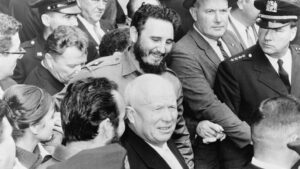
- The following day, the CIA reported that four missile sites at San Cristobal and two missile sites at Sagua la Grande were operational.
- On 27 October, Radio Moscow broadcasted Khrushchev’s message. Khrushchev offered a trade. The Soviet would remove its missiles from Cuba, if the US would remove its Jupiter missiles from Italy and Turkey.
- On the morning of 27 October US time, a U-2F piloted by Major Rudolf Anderson was shot down by a SA-2 surface-to-air missile launched from Cuba. As a result, tension increased. Later on, the Soviets claimed that the act was an isolated decision of the Cuban military.
- After a series of negotiations, JFK was almost persuaded to take Khrushchev’s proposal. Despite the opposition of the EXCOMM and repeated plea of the Turkish government, JFK drafted a compromised letter.
- The letter included (1) the removal of Soviet missiles from Cuba under the supervision of the US, (2) removal of US quarantine measures, and (3) non-invasion of Cuba.
- Without involving the Politburo, Khrushchev drafted an acceptance letter and had it delivered over Radio Moscow.
- After deliberation between the US and USSR governments, US missiles in Turkey and southern Italy were removed. Meanwhile, the Soviet broadcast announced the dismantling of missiles from Cuba.
- Through aerial reconnaissance, the dismantling of missiles was observed by the US government. About 42 missiles were loaded onto Soviet ships. Between 5 to 9 November, Soviet ships left Cuba.
- On 20 November 1962, the US announced the end of the quarantine.
- At that time, the US removal of Jupiter missiles from Italy and Turkey was not made public. As a result, many Soviets were under the impression that Khrushchev had lost the conflict.

